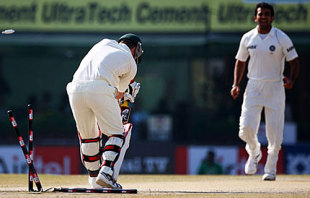India's winning habit
The second Test at Mohali was a rare happening as the Australians were toyed around and thoroughly dominated by India
Cricinfo staff
21-Oct-2008

| ||
Trucks in the Punjab are famous for the one-line messages they carry. One of the typically earthy ones is, "Vekhi ja, par chedi na [Keep watching my truck, but don't fiddle around]." For four days and a bit in Mohali, India were the runaway truck that Australia could only watch and do nothing about.
It is a rare happening: When was the last time a team toyed around with Australia? When was the last time Australia were so dominated? One has to go back more than 10 years, to the same opposition and country, to Eden Gardens 1997-98. So long ago that only five players, on both sides, from that Test played in this match. Between Eden Gardens and Mohali, Australia played 117 matches, losing 15, without being so completely outplayed even once.
What would be more satisfactory for India, though, is that this win didn't come on a crumbling dustbowl; home advantage counted for nought this time. It was a good batting track, looking like any Australian pitch, with a little less bounce, on the first day. Contrast this with Eden Gardens 1998, when India played with three spinners, and Sourav Ganguly opened the bowling. Over the last five days, though, and on the same pitch, the ball would lose all potency the moment it was handled by Australian bowlers.
To be fair to the Australians, this isn't the same team that dominated the world over the last decade. Some of the best players in that side - Shane Warne, Adam Gilchrist, Glenn McGrath and Justin Langer - have gone. Also, they embarked on this tour - possibly their toughest assignment of recent times - without Andrew Symonds; discipline problem or not, it's a mistake they may yet come to regret. Even so, it would take a special effort to put the boot in, simply because of their winning habit and the belief that they can pull themselves out of any kind of strife.
| "Especially at one time in the first innings, they [Australia] were 22 from 13 overs. I said to Rahul [Dravid], 'Look at the board, we won't see that again'"Mahendra Singh Dhoni | |||
It's perhaps fitting that this defeat has been inflicted by India, who have stood up to Australia, competed against them more consistently than any other team in the past decade. And India are the only team who constantly threaten to outskill them: once it was their mysterious spin bowling and imperious batting, here the biggest difference between the teams was the quality of the pace bowling.
While Australia struggled for any disconcerting movement, the Indian bowlers got prodigious swing, both conventional and reverse. A TV split-screen visual of the six-over-old ball being used by both the teams told a story. While the one Australia used was scuffed up all over, the one India used had two markedly different sides, shiny and rough. That meant the ball started reversing as early as in the ninth over at times, a sensational phenomenon. And since it's still hard and new that early, as MS Dhoni suggested, it was all the more difficult to face. "The ball [from Ishant Sharma] that got me would get me 95 times out of 100," Ricky Ponting confessed.
The batsmen and the spinners did their job too. Gautam Gambhir and Virender Sehwag gave India two fiery starts, putting Australia on the back foot right away. The middle order revived them after a brief blip. Amit Mishra's debut was phenomenal, a throwback to the old days of classical legspin bowling. And Harbhajan Singh fast-tracked Australia to their demise in the second innings.
Right from the toss, India did little wrong. The one potentially distracting period was when Tendulkar moved towards his record but India regrouped well. They were aggressive throughout, and there wasn't a single player in the side they needed to hide. You could say they had nine potential Man-of-the-Match winners, something we rarely see with the Indian team. Perth, earlier this year, was a team performance, but not nearly as destructive.

| ||
It can be argued the destruction started even before the toss. Perhaps Zaheer Khan had sensed in Bangalore that this Australian team could do with some dominating. The debate over who won the moral victory in Bangalore can continue but it's clear who gained more from that result.
Two moments summed up the match for India and Australia. One of them came early on the second day. India had contrived to keep Australia in the game on day one, even though the latter chased leather throughout the day. At 326 for 6, India were still capable of being bundled out for a below-par total. In walked Dhoni, and he got a bouncer first-up. He hooked that for four, then hit another for a six, and "the most defensive side in a long time" was being taken to the cleaners.
Then, on the fourth morning, India played Australia at their own game, applying ruthlessness and urgency - and clarity of thought - in their approach to setting the target, and giving themselves close to 130 overs to bowl out a side low on confidence. And when Matthew Hayden tried to intimidate the bowlers, they didn't take a step back. The inevitable soon happened and, as it usually happens in India, it happened too fast once it started.
Naturally Dhoni was pleased with his team's effort. "I've never seen anything like that," he said. "Especially at one time in the first innings, they were 22 from 13 overs. I said to Rahul [Dravid], 'Look at the board, we won't see that again.'"
The way this Indian team is playing, don't bet on it.